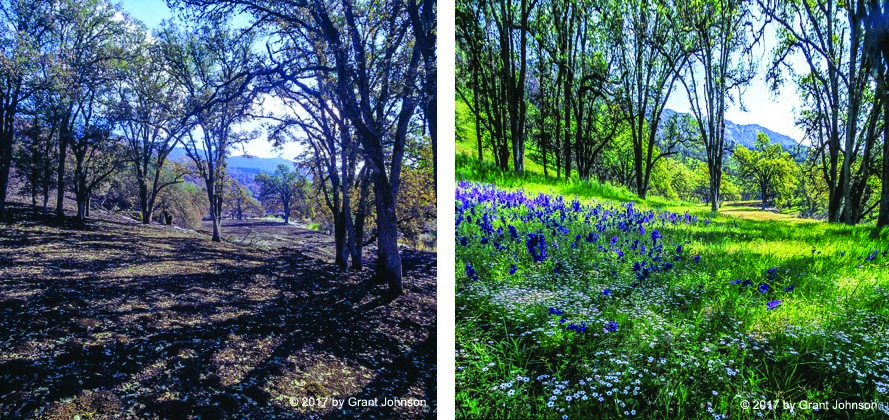by Shoshana Hebshi, Redwood Chapter Communications Coordinator
While our communities rebuild from the devastating wildfires that began Oct. 8 and 9 and swept across our region, we are heartened by the outpouring of support and community-building efforts that have helped us heal and get back on our feet.
When we look around at the charred landscape that surrounds our neighborhoods, we are reminded daily of the immense power of the firestorm that took 42 lives and burned 8,500 structures and 245,000 acres across four counties.
There’s a human impulse to rebuild, to resume life as it was. In nature, there is the cycle of regeneration that comes after a fire. While our instinct tells us to help and our hearts are in the right place, in most cases, it’s best to let nature heal itself.
Vegetation. Most immediately spotted are the blackened hills, the brown trees and patches of nothing where trees, brush or grass once grew. In our minds, when we see charred landscape we assume it’s dead. But California plants have adapted to fire, and some even require fire to grow and spread. It is an essential part of the ecosystem.
According to CalFire, native plants like ceanothus and lodgepole pine need fire to germinate, and some faunal species, such as black-backed woodpeckers can reproduce only in trees that have been killed by fire. Oaks and redwood are especially fire adapted. After a fire, if the cambium just under the bark is white or pink, the tree will most likely revive. It is recommended that property owners wait a year before cutting down a burned native tree unless it presents a danger, and pruning of dead limbs is advised.
The spring following the 2015 Valley Fire in Lake County, which destroyed much of the community of Middletown, saw an abundance of wildflowers blooming over the once-charred landscape. The blooms were so intense, it drew gawkers from all around. Botanist Karen Sullivan said some of the native wildflowers called “fire followers” need the fire to sprout and bloom.
Hot fires crack the hard coats of seeds, which may have been dormant for decades, and facilitate germination when rain arrives, according to Greg Giusti, a forest and wildland ecology advisor with the University of California Extension. He told the Press Democrat in 2016 that fire is an “integral part of California landscape.”
Animal life will also rebound in its own time. Pamela Jackson of Redwood Chapter’s Napa Group writes “lichens and fungi (morels!) will blow in with nature's greatest pollinator, the wind. Insects will find the snags, set up house, and pollinate pioneer plants. Wood burrowing beetles with infrared receptors quickly lay larvae that sustain woodpeckers. Those woodpeckers provide cavity nesting sites for swallows, bluebirds, and wrens.”
Plant and animal life will recover after a fire as long as we let it run its natural course and resist kneejerk reactions to repopulate the land with imported seeds or vegetation. “This is a resilient landscape, if we give it a chance,” said Redwood Chapter Chair Victoria Brandon, a Lake County resident.
Waterways. Following fire, waterways can be impacted in a number of ways. According to CalFire, the decreased vegetation means more water will run into streams and lakes as it is not being soaked up by roots. After a fire that burns as many homes and structures as the Tubbs and Nuns fire burned in Santa Rosa, Sonoma, Glen Ellen and Kenwood, watershed managers are nervous about incoming rain washing toxic ash into the waterways.
According to the Press Democrat, there are 617 streams in fire-affected areas that could have an impact on aquatic life and drinking water. City and county workers are working to offset the runoff by placing gravel bags and straw wattles around storm drains to divert and absorb runoff.
Rebuilding. California is the most populous state in the nation and the third-largest by area. While most of the population is concentrated in cities, the state has had a general expansion of suburban communities moving outward from city centers for decades. Housing density generally loses to the sprawl of single-family homes and the strip-malls that accompany them in outer-lying subdivisions. As homes are built farther out into fire-prone wildland areas, property loss and death resulting from wildfires has increased.
CalFire says the housing incursion into wildland areas “makes it difficult to maintain the natural role of fire and to protect human lives and property.”
According to Jon Keeley, a research ecologist with the U.S. Geological Survey, about one-third of Californians live in fire-prone areas encroaching on wildlands. “We need to respect the fact that these are going to happen in the future and that what we need to do is we need to have communities adapt to the fires,” he said on NPR on Oct. 25.
While Northern California works to rebuild from the October fires, there is work and soul searching to do about what kind of communities we want to live in.
Sierra Club has long advocated for growth and development that takes ecosystems, transit and affordability into account. Rushing to rebuild without taking into consideration these ideas to make a community more livable and equitable could hurt the area more than help it recover. In other words, this is an opportunity to repudiate urban sprawl and concentrate new housing in areas where employment, public services and public transportation already exist.
On a personal level, residents can evaluate their individual fire risk and maintain properties to lessen risk by installing fire-resistant landscaping, mowing regularly, trimming trees and removing flammable debris.
Sonoma Group Chair Teri Shore said now is the time to break the pattern of poor development decisions. “Now we need to do it, you know, stop talking and planning but actually start building in the right places in the right way,” she said.

Plant and animal life rebound after fires, as seen here in Lake County following the 2015 Valley Fire. We must be patient to allow nature to heal itself.